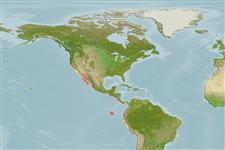Actinopterygii (ray-finned fishes) >
Perciformes (Perch-likes) >
Polynemidae (Threadfins)
Etymology: Polydactylus: Greek, poly = a lot of + greek, daktylos = finger (Ref. 45335).
Environment / Climate / Range
Ecology
Marine; brackish; demersal; depth range 10 - 60 m (Ref. 91172). Subtropical, preferred ?; 37°N - 12°S, 122°W - 77°W (Ref. 57343)
Eastern Pacific: Monterey Bay, California, USA to Callao, Peru. One record from the Galapagos Islands. Rare north of Baja California, Mexico (Ref. 2850). Record from Chile (Ref. 9068) needs to be verified (Ref. 57343).
Size / Weight / Age
Maturity: Lm ? range ? - ? cm
Max length : 36.0 cm TL male/unsexed; (Ref. 2850); common length : 20.0 cm TL male/unsexed; (Ref. 55763)
Dorsal
spines
(total): 9;
Dorsal
soft rays
(total): 11-13;
Anal
spines: 3;
Anal
soft rays: 13 - 15;
Vertebrae: 24. Body grayish, no stripes or spots. Lip on lower jaw well developed. Dentary teeth restricted to dorsal surface. Maxilla not covered with scales. Pectoral filaments 6; longest not reaching beyond level of posterior end of anal fin base. Lateral line bifurcated on caudal fin membranes, extending to posterior margins of upper and lower caudal fin lobes. Swim bladder present (Ref. 45049).
Found in shallow water near the coast, on sand and mud bottoms (Ref. 9332). Larvae and small juveniles (>4 cm) are pelagic and sometimes occur several hundred kilometers offshore, whereas the larger juveniles and adults prefer shallow near-shore waters like bays, sloughs or estuaries where the bottom is sandy or muddy (Ref. 28023). Omnivorous, feeds on worms, sand crabs, shrimp, clams; sometimes feeds on fish like small anchovy (Ref. 28023). Esteemed food fish where it occurs (Ref. 57343). Also Ref. 55763.
Life cycle and mating behavior
Maturity | Reproduction | Spawning | Eggs | Fecundity | Larvae
Motomura, H., 2004. Threadfins of the world (Family Polynemidae). An annotated and illustrated catalogue of polynemid species known to date. FAO Spec. Cat. Fish. Purp. Rome: FAO. 3:117 p. (Ref. 57343)
IUCN Red List Status (Ref. 115185)
CITES (Ref. 94142)
Not Evaluated
Threat to humans
Harmless
Human uses
Fisheries: commercial
More information
ReferencesAquacultureAquaculture profileStrainsGeneticsAllele frequenciesHeritabilityDiseasesProcessingMass conversion
Tools
Special reports
Download XML
Internet sources
